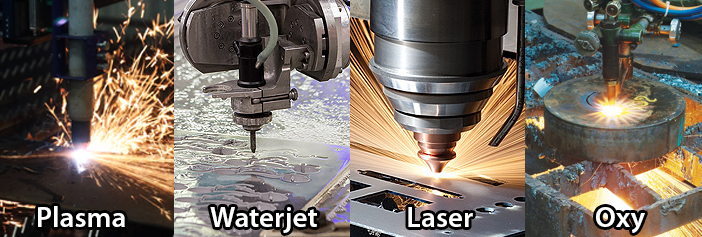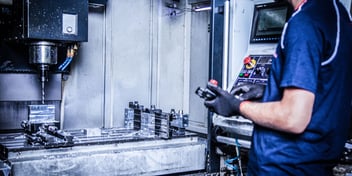Plasma vs Waterjet vs Laser vs Oxy | How Economical is CNC Plasma?
What’s this about?
We often get asked how CNC plasma compares with waterjet, oxy or laser… when it comes to cutting steel and metals.
In this article, we’re going to cover 3 areas;
- Purchase cost
- Running cost & productivity
- Cut quality and precision
This article primarily focuses on industrial cutting systems for metal fabricators needing to cut materials up to 25-30mm thick… in particular, fabricators that may be investing in CNC capability for the first time.
Cut the waffle, just give me the facts!
Just in case you’re in a hurry, here’s our quick summary!
| Process | Purchase Cost ? | Running Cost ? | Speed ⏲️ | Cut Quality ✂️ |
| CNC Plasma | Low Cost | Low Cost | Fast | Good |
| Oxy | Low Cost | High Cost | Slow | Varies |
| Waterjet | High Cost | High Cost | Very Slow | Excellent |
| Laser | High Cost | High Cost | Fast | Excellent |
*Based on single torch system only and typical material thickness up to 25-30mm
Purchase Cost
In terms of equipment cost, or affordability, CNC plasma is the clear winner, with industrial-quality systems available from less than $30,000 (In fact we offer CNC Plasma Table packages starting from less than $25,000 or $19 per day finance cost).
Because Oxy is usually only considered for thicker materials, CNC tables configured for Oxy tend to be larger and heavier and therefore Oxy typically has a higher ‘entry’ cost than Plasma.
Waterjet and Laser equipment cost typically starts at around $100,000+, making these systems by far the most expensive to purchase.
Running Cost & Productivity
To get a true picture of the cost to produce an item, running costs should be compared alongside productivity (or speed). For example, a machine might have a high cost per hour, but is able to produce a higher volume of parts per hour… or vice-versa.
Once again, CNC Plasma comes out on top with both a low operating cost and fast cutting speed. The main costs with plasma are consumable torch parts and power. It should be noted that the quality of plasma machine (& torch) will also make a big difference, you can read more about this topic here.
Oxy is comparatively higher cost, due to the cost of oxygen and fuel gas (and cylinder rental costs). The need for pre-heating before starting each cut also reduces speed and productivity. Although this article relates to cutting thicknesses of up to 25-30mm, we will note that oxy can become more economical to run when cutting mild steel in thicknesses of 30-50mm and above.
Waterjet and Laser are typically much more expensive to operate, requiring specialist gases and other high-cost consumables. When cutting thin materials with laser, very high cutting speeds can be achieved which can help to reduce the cost per part. Waterjet is both slow and costly to run, making it the least-productive system to operate.
Another factor to be aware of is the cost in the event of breakdown (eg: torch damage/wear/malfunction), where Laser and Waterjet are typically much more expensive to repair.
Cut Quality and Precision
Waterjet and Laser are both expensive to purchase and run, however they’re the clear winners on cut quality and precision. Very square cut with little or no dross, pierce spatter or heat distortion.
While CNC Plasma can’t boast the same ‘perfect’ cut quality as Waterjet & Laser, it should be noted that plasma technology has come a long way and continues to be a widely-used, fast-growing technology. Plasma will always have some degree of edge bevel angle and some dross. Heat distortion is usually only a concern when cutting materials less than 3mm thick (eg 1.6mm or less). These imperfections can be minimised by using reputable, quality equipment and correct operator technique. For many industrial applications, Plasma is more than ‘good enough’ with the benefits of being relatively simple to operate and cost-effective to both own and run.
Oxy varies considerably. On thinner materials especially, cut quality is very poor with a lot of heat distortion. For this reason Oxy is not usually an option where there is a need to cut thin steel, or where one single machine/system is required to cut a range of material thicknesses. (Also note that Oxy will only cut ferrous metal, eg carbon steel).
Cut to the chase…..
CNC Plasma = Affordable, quality & fast cutting of most metals (with the right equipment)
Oxy = Suitable only for carbon steel. Not ideal for thinner material, worth considering if frequently cutting heavy steel plate.
Laser = High cost, but very high quality, fast cutting of most metals & some non-metallic materials
Waterjet = High cost, slow, but exceptional quality cutting of nearly any metallic or non-metallic material
So… How Much Does a CNC Plasma Cost?
This depends on the model of CNC unit, plasma cutter, and any additional accessories that you chose.
Read our guide on CNC plasma costs, or get an instant online price here.
Got A Question?
We’d love to help. Contact us today!
Why our CNC Packages are a cut above the rest:

Do you need to be a computer geek to run a CNC Plasma Table?
No! Click here to check out the most user-friendly software on the market.
Disclaimer: This information is for general reference only and may not accurately pertain to your situation or intended application. This article relates solely to the cutting of metals, especially mild steel. The information in this article is given from our overall perspective of industrial cutting systems for entry-level users who typically cut materials up to 25-30mm. Actual comparisons between one system and another will vary for different material thicknesses and applications. Buyers should conduct their own research to determine the ideal product for their application. E.&O.E.
Looking for a CNC Plasma Table? You need to know about the most user-friendly software on the market.





